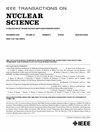Degradation Under Low Drain Bias Induced by Heavy Ion in SiC MOSFETs
IF 1.9
3区 工程技术
Q3 ENGINEERING, ELECTRICAL & ELECTRONIC
引用次数: 0
Abstract
The safe operating area (SOA) for the drain bias of silicon carbide (SiC) metal oxide semiconductor field effect transistors (MOSFETs) in space applications has been limited due to the single-event effects (SEEs) induced by heavy-ion irradiation. At a drain bias lower than 5% of the rated voltage, SiC MOSFETs are typically considered to be in the charge collection region, which usually does not cause destructive damage. However, in this article, the degradation induced by heavy ions at drain biases below 50 V for 1200 V SiC MOSFETs has been observed. During irradiation, the drain leakage current (碳化硅 MOSFET 在重离子诱导的低漏极偏压下的性能退化
由于重离子辐照引起的单次事件效应(SEE),碳化硅(SiC)金属氧化物半导体场效应晶体管(MOSFET)在太空应用中漏极偏置的安全工作区(SOA)一直受到限制。在漏极偏压低于额定电压的 5%时,SiC MOSFET 通常被认为处于电荷收集区,通常不会造成破坏性损坏。然而,本文观察了 1200 V SiC MOSFET 在漏极偏压低于 50 V 时由重离子引起的退化。在辐照过程中,漏极漏电流(${I} {_{\text {DSS}}$ )随着累积剂量的增加而持续增加。同时,${I} {_{\text {DSS}}$ 的衰减显示出 SiC MOSFET 的漏极偏置和单元拓扑结构之间的相关性。辐照后,仍然观察到不可接受的 ${I} {_{\text {DSS}}$ 退化,但经过一个月的室温退火后,退化程度恢复了约 40%。 在负栅极偏压条件下,{I} {_{\text {DSS}}$ 也恢复到了辐照前的水平,这表明{I} {_{\text {DSS}}$ 的增加可能与通过沟道区的漏电流路径有关,该路径由氧化物内部或 SiO2/SiC 界面上的缺陷造成,可能是由微剂量效应引入的。在 25 °C-250 °C 的温度范围内测试了栅极漏电流(${I} {_{text\ {GSS}}$ ),以研究温度对栅极氧化物潜伏损伤激活的影响。随着辐照过程中漏极偏压的增加,{I} {_{\text {GSS}}$ 在较高温度下也显著增加,这表明栅极氧化物内部在辐照过程中形成了潜在损伤。
本文章由计算机程序翻译,如有差异,请以英文原文为准。
求助全文
约1分钟内获得全文
求助全文
来源期刊

IEEE Transactions on Nuclear Science
工程技术-工程:电子与电气
CiteScore
3.70
自引率
27.80%
发文量
314
审稿时长
6.2 months
期刊介绍:
The IEEE Transactions on Nuclear Science is a publication of the IEEE Nuclear and Plasma Sciences Society. It is viewed as the primary source of technical information in many of the areas it covers. As judged by JCR impact factor, TNS consistently ranks in the top five journals in the category of Nuclear Science & Technology. It has one of the higher immediacy indices, indicating that the information it publishes is viewed as timely, and has a relatively long citation half-life, indicating that the published information also is viewed as valuable for a number of years.
The IEEE Transactions on Nuclear Science is published bimonthly. Its scope includes all aspects of the theory and application of nuclear science and engineering. It focuses on instrumentation for the detection and measurement of ionizing radiation; particle accelerators and their controls; nuclear medicine and its application; effects of radiation on materials, components, and systems; reactor instrumentation and controls; and measurement of radiation in space.
 求助内容:
求助内容: 应助结果提醒方式:
应助结果提醒方式:


